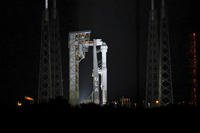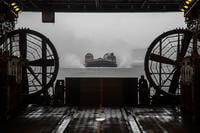Thermobaric warheads put the power to demolish buildings into the hands of the average U.S. marine. But Americans arent the only ones with the weapons. The Chinese, the Russians -- even guerilla groups -- now have thermobarics' shockingly destructive power in their grasps. Thermobarics aren't just a more powerful version of normal high explosive. The term encompasses a range of different types of warhead from fuel-air explosives, which release a cloud of flammable material and detonate it, to metallized explosives whose expanding fireball takes in oxygen from the air. What they have in common is that they produce blast which has a lower overpressure but a longer duration than normal condensed explosives. In effect it is a shove rather than a punch: a thermobaric explosion does not smash a hole in a wall, it pushes the wall over. An instantaneous explosive overpressure of 50 psi [pounds per square inch] is needed to kill. But one sustained for a fraction of a second at 10 psi is also lethal. Thats how thermobarics kill.
Thermobarics aren't just a more powerful version of normal high explosive. The term encompasses a range of different types of warhead from fuel-air explosives, which release a cloud of flammable material and detonate it, to metallized explosives whose expanding fireball takes in oxygen from the air. What they have in common is that they produce blast which has a lower overpressure but a longer duration than normal condensed explosives. In effect it is a shove rather than a punch: a thermobaric explosion does not smash a hole in a wall, it pushes the wall over. An instantaneous explosive overpressure of 50 psi [pounds per square inch] is needed to kill. But one sustained for a fraction of a second at 10 psi is also lethal. Thats how thermobarics kill.
The basic idea goes way back, and anyone interested in the background - including a bizarre German WWII weapon, how a 500lb of coal dust can break windows five miles away and what new ultra-fine nanoexplosives can do - should put my book Weapons Grade on their Christmas list.
But the thermobaric threat isnt confined to history books. In Iraq and Afghanistan, many US lives have been saved by the protection afforded by armored patrol vehicles, body armor and prompt medical attention. Thermobarics may change that. Armored vehicles are safe only when buttoned up, as the blast from a thermobaric warhead will 'flow' through hatches or other openings.
A detailed analysis points out that "conventional countermeasures such as barriers (sandbags) and personnel amour are not effective against thermobaric weaponry."
Other research indicates that current ballistic body armor actually increases the severity of blast injuries. Similarly, current combat medicine is not geared to deal with the damage to lungs and intestines which are typical of thermobarics - "diagnosis and treatment of blast injuries may require computed tomography, which might not be readily available in the battlefield." In 1988, the Russians were the first to field a shoulder-launched thermobaric weapon, the RPO-A. It is also known as Shmel or Schmel from the Russian for Bumblebee.
In 1988, the Russians were the first to field a shoulder-launched thermobaric weapon, the RPO-A. It is also known as Shmel or Schmel from the Russian for Bumblebee.
As with the Marines thermobaric SMAW-NE weapon, the Shmel is quite capable of destroying buildings as this video shows. The Shmel complemented a wide range of other thermobaric weapons including bombs, rockets and artillery in the Russian arsenal. Controversially, security forces used the Shmel in the school siege at Beslan, a questionable choice for a hostage situation.
New Russian developments include a compact multi-shot thermobaric grenade launcher for urban combat and a thermobaric warhead for the RPG-7 used by guerrilla forces worldwide. Similar products are offered for export by the Bulgarians and other Eastern European nations.
Rumors of a Chinese licensed copy of the Shmel appear to be confirmed with the emergence of this clone - it has the same calibre, same appearance and described as "fuel air blasting explosive". Its effectiveness against buildings, bunkers is noted, as well as the fact that because the blast takes oxygen from the air, "personnel in the airtight space suffocates because of the oxygen deficit."
Are such weapons in the hands of insurgents and terrorists? During the Chechen conflict, there were persistent stories that Chechen separatists had them:
"The Russian force, to explain extensive damage to buildings in Grozny, stated that the Chechens had captured a boxcar full of Shmel weapons and were now using them indiscriminately," one report noted. Newspapers reported that the weapons were recovered from Chechen arms caches
However, according to Tourpal-Ali Kaimov, a Chechen commander interviewed by the USMC only a handful of Shmel were captured.
The Russian claim that the Chechens captured a 'box car' load of these weapons was part of a Russian disinformation campaign. The indiscriminate use of these weapons combined with its destructive capabilities produced a lot of collateral damage and deaths/injuries among non-combatants. The Russian claim was a ruse in order to place at least part of the blame on Chechen use of the Schmel.
There is at least one documented instance of an irregular force receiving Shmel: the Cobra militia in the Republic of Congo reported in 2003.
Among these shipments were significant quantities of the RPO-A 'Shmel', an extremely lethal hand-held launcher whose projectile uses fuel-air explosive... This is the first time this weapon has been seen in the possession of a non-state actor.
The report, by the Swiss-based Small Arms Survey group, does not identify the source of the weapon, but does provides photographic evidence.
So far, insurgents in Iraq havent gotten their hands on thermobaric weapons. And reports from Afghanistan describing thermobaric victims as being found dead without a mark on them have been overstated -- and allegations about 'displaced eyeballs' -- are highly doubtful. But it would seem only a matter of time until these weapons make them into the worlds most intense conflicts.
Some attention has been paid to the threat posed by thermobarics, but little has been made public. In a series of computer simulations called Project Albert, the Marine Corps Warfighting Laboratory has evaluated the effect of arming platoons of attackers and defenders with enhanced blast weapons in urban assault. The results are significant - when the attackers alone are armed with them, they are much more successful, but when both sides have them the advantage shifts towards the defenders.
This may be important for the future of warfare in cities. The spread of these weapons will make such actions more destructive, and it will make infantry assault even more costly in terms of lives.
Agreement on an international ban on the manufacture and export of such weapons might have been possible some years ago, but now the genie is well and truly out of the bottle. Now it is a matter of preparing ourselves with better tactical awareness of what such weapons can do, and improving the medical facilities for dealing with thermobaric casualties.
-- David Hambling







